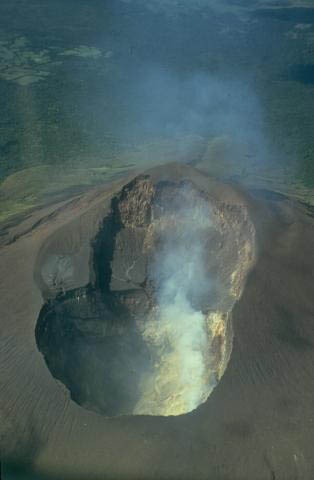
Other ITA web sites:


Telica Volcano, Nicaragua

The aerial view on July 1987 (top left) looks almost directly down into the double summit crater of Telica volcano in Nicaragua.
An older shallower crater is located on the SW side (top).
Steam rises from fumaroles in the NE crater (bottom), the source of recent eruptions.
The steep-walled crater is 120 m deep.
Ash from frequent historical eruptions keeps the outer slopes of the cone unvegetated.
Telica, one of Nicaragua's most active volcanoes, has erupted frequently since the beginning of the Spanish era.
The Telica volcano group consists of several interlocking cones and vents with a general NW alignment.
Sixteenth-century eruptions were reported at symmetrical Santa Clara volcano at the SW end of the Telica group.
However, its eroded and breached crater has been covered by forests throughout historical time, and these eruptions may have originated from Telica, whose upper slopes in contrast are unvegetated.
The steep-sided cone of 1061-m-high Telica is truncated by a 700-m-wide double crater; the southern crater, the source of recent eruptions, is 120 m deep.
El Liston, immediately SE of Telica, has several nested craters.
The fumaroles and boiling mudpots of Hervideros de San Jacinto, SE of Telica, form a prominent geothermal area frequented by tourists, and geothermal exploration has occurred nearby.
The 700-m-wide double summit crater of Telica volcano is seen here in an aerial view from the north with farmlands of the Nicaraguan depression in the background.
The 1061-m-high volcano is the highest and most recently active of the Telica volcanic complex.
The Telica volcano group consists of several interlocking cones and vents with a general NW alignment.
The bench at the lower right and the ridge at the left are remnants of older craters of the complex.
PHOTO SOURCE: William Melson 1987 and Jaime Incer 1991, courtesy of the Global Volcanism Program, Smithsonian National Museum of Natural History, used with permission, and Wikimedia Commons.
NOTE: The information regarding Volcano on this page is re-published from other sources. No claims are made regarding the accuracy of Volcano information contained here. All suggestions for corrections of any errors about Volcano photos should be addressed to the copyright owner noted below the photo.